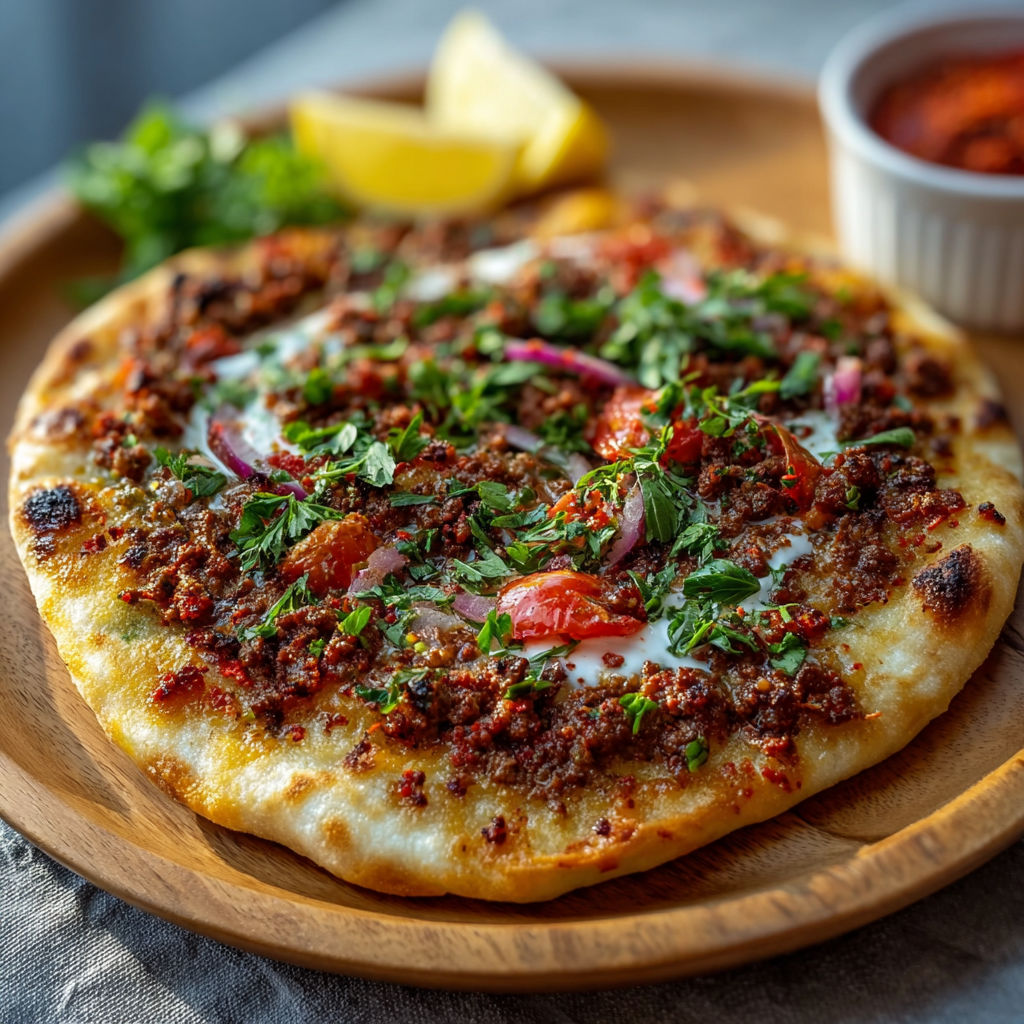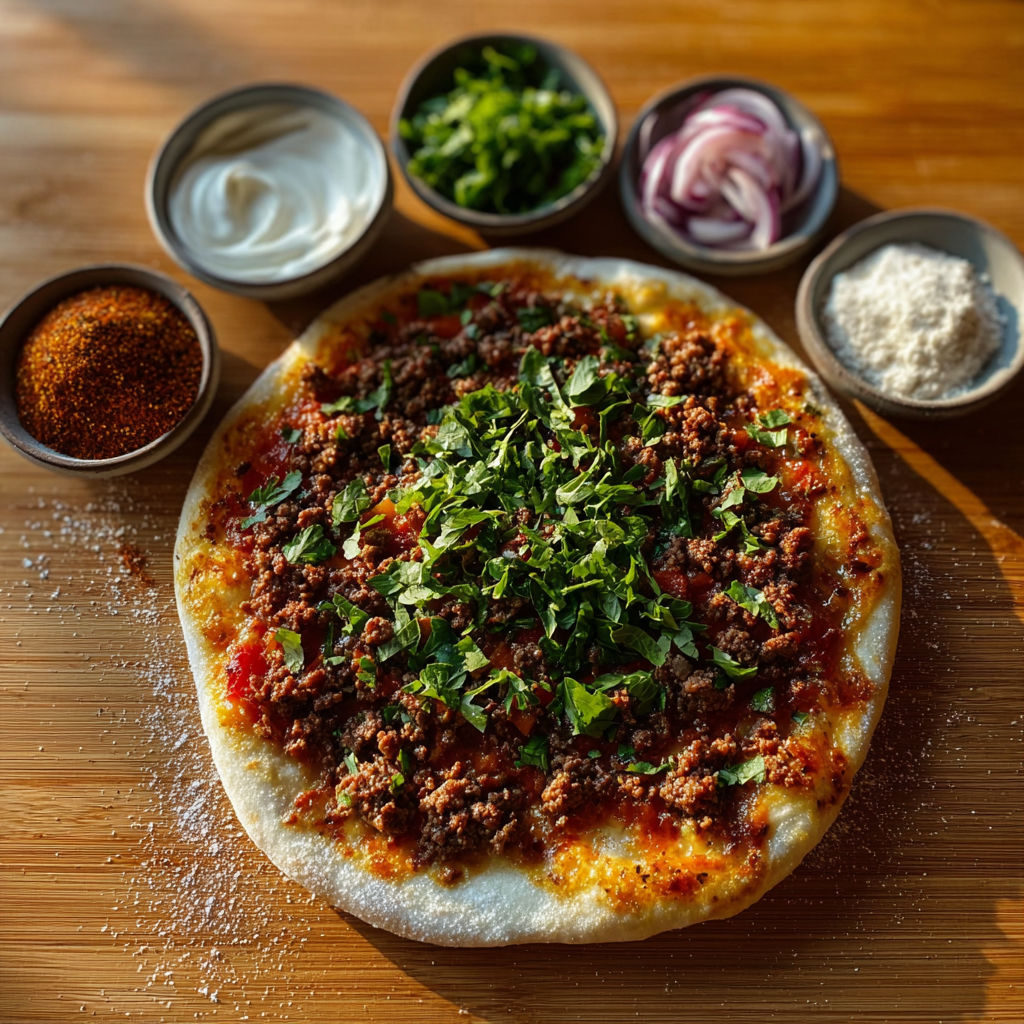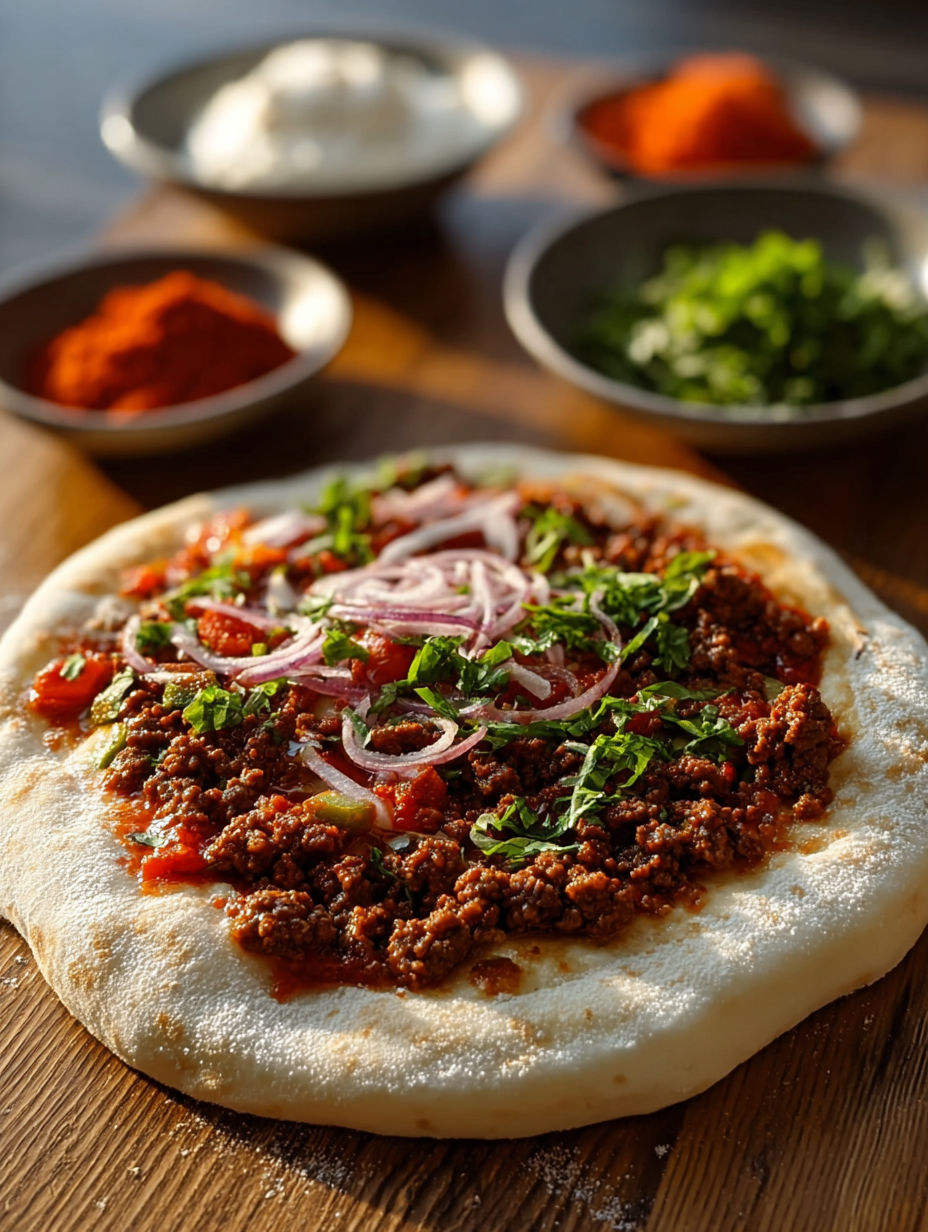 Pin
Pin
This homemade lahmacun brings the authentic taste of Turkish street food right to your kitchen. The crispy thin crust topped with aromatic spiced meat creates that perfect balance of flavors that makes this dish so beloved throughout the Middle East. After years of experimenting with different recipes, I finally perfected this version that rivals even my favorite Turkish restaurant.
I first tried making lahmacun after a memorable trip to Istanbul where I became obsessed with these crispy meat-topped flatbreads. After several attempts, this recipe finally captured that authentic street food flavor that transported me right back to the bustling markets of Turkey.
Ingredients
- For the Dough
- Warm water activates the yeast and creates the perfect texture
- Sugar feeds the yeast for proper fermentation
- Active dry yeast provides the perfect rise without overwhelming yeast flavor
- All purpose flour works perfectly though you can substitute bread flour for extra chewiness
- Salt enhances flavor and strengthens the dough structure
- Olive oil adds tenderness and a subtle richness to the crust
- For the Topping
- Ground lamb traditional and authentic though beef works wonderfully too
- Onion provides sweetness and moisture essential for the perfect texture
- Green bell pepper adds freshness and subtle crunch
- Fresh tomatoes bring brightness and acidity to balance the rich meat
- Tomato paste concentrates flavor and helps bind the mixture
- Fresh parsley provides color and herbaceous notes
- Red pepper flakes add customizable heat use authentic Aleppo pepper if available
- Paprika brings smoky depth and beautiful color
- Cumin adds earthy warmth essential to Middle Eastern cuisine
- Allspice and cinnamon bring authentic Turkish flavor notes
- Salt and pepper balance and enhance all other flavors
How To Make Lahmacun
- Activate the yeast
- Combine warm water sugar and yeast in a large bowl. The water should feel like comfortable bath water about 110°F. Let the mixture sit undisturbed for 5 to 10 minutes until foamy and fragrant. If it doesn't foam your yeast might be old or your water too hot.
- Create the dough
- Whisk flour and salt in a separate bowl then add to the yeast mixture along with olive oil. Mix until a shaggy dough forms. The dough will look rough at first but will smooth out during kneading. Turn onto a lightly floured surface and knead vigorously for 5 to 7 minutes. The dough should become smooth elastic and spring back when poked.
- First rise
- Place the dough in an oiled bowl turning once to coat all sides. Cover with plastic wrap or a damp kitchen towel and let rise in a warm draft free spot for 1 to 2 hours. The dough should double in size and feel airy when pressed. For best flavor let it rise the full time.
- Prepare the topping
- While the dough rises combine all topping ingredients in a large bowl. Mix thoroughly using your hands to fully incorporate all spices evenly. Let the mixture rest at room temperature for at least 30 minutes to allow flavors to meld. This step makes a significant difference in the final flavor profile.
- Shape the lahmacun
- Preheat oven to 450°F and line baking sheets with parchment paper. Punch down the risen dough to release air bubbles. Divide into 6 to 8 equal portions using a bench scraper or knife. Roll each portion on a floured surface into very thin circles about 8 to 10 inches in diameter. The thinner the better for authentic results.
- Apply the topping
- Spread a thin layer of meat mixture over each dough circle leaving a small border around the edges. Use your fingertips to spread the mixture extremely thinly. The layer should be almost translucent in spots. A thick layer will make the lahmacun soggy.
- Bake to perfection
- Transfer topped dough carefully to prepared baking sheets. Bake for 10 to 15 minutes until the edges are golden brown and the meat is fully cooked. For extra crispness bake on preheated pizza stones if available.
The cumin in this recipe is absolutely essential dont skimp on it. My Turkish neighbor taught me that properly toasting the cumin in a dry pan before adding it to the meat mixture elevates the entire dish. This simple step creates a depth of flavor that reminds me of the incredible lahmacun I ate at a tiny family restaurant in Istanbul where they had been making it the same way for generations.
Make Ahead Options
Lahmacun components can be prepared in advance for easier meal planning. The dough can be made up to 24 hours ahead and refrigerated after the first rise. Simply punch it down cover tightly and store in the refrigerator. Let it come to room temperature for about 30 minutes before shaping. The meat topping can also be prepared a day ahead and refrigerated in an airtight container which actually improves the flavor as the spices have more time to meld.
Serving Traditions
In Turkey lahmacun is typically served with lemon wedges and a pile of fresh herbs including parsley mint and sometimes arugula. The traditional way to eat it is to squeeze lemon juice over the hot lahmacun sprinkle with herbs then roll it up and eat it like a wrap. Some people add sliced onions tomatoes or even pickles before rolling. For a more substantial meal serve with cacik a Turkish yogurt and cucumber dip similar to tzatziki.

Regional Variations
While lahmacun originated in the Middle East there are countless regional variations throughout Turkey Armenia and surrounding countries. Some versions use a spicier meat mixture while others incorporate different herbs or spices. In some regions cooks add a small amount of minced garlic or even pomegranate molasses to the meat mixture for additional complexity. The thickness of both the dough and meat topping also varies by region with some preferring an almost paper thin crust and others enjoying a slightly thicker base.

Recipe FAQs
- → Can I make lahmacun dough ahead of time?
Yes, you can prepare the dough up to 24 hours in advance and keep it refrigerated. Allow it to come to room temperature for 30-60 minutes before rolling. You can also freeze the dough balls for up to 3 months - just thaw overnight in the refrigerator before using.
- → Is there a vegetarian alternative to lahmacun?
Absolutely! You can create a delicious vegetarian version by substituting the meat with a mixture of finely chopped mushrooms, walnuts, and lentils. Add the same spice blend for authentic flavor. Some cooks also use plant-based meat alternatives with good results.
- → How do I achieve a thin crust for lahmacun?
The key to authentic lahmacun is rolling the dough very thin. Use a rolling pin on a well-floured surface and roll from the center outward. The dough should be almost translucent - about 1/8 inch thick or less. If you have one, a pasta machine can help achieve an even thickness.
- → What's traditionally served with lahmacun?
Lahmacun is typically served with fresh lemon wedges for squeezing over the top, and herbs like parsley, mint, or arugula. Many people add sliced onions, tomatoes, and sometimes a light yogurt sauce. In Turkey, it's common to roll the flatbread around the fresh herbs and vegetables and eat it like a wrap.
- → Can lahmacun be reheated?
Yes, lahmacun reheats well. For best results, warm it in a 350°F (175°C) oven for about 5 minutes until heated through. You can also use a skillet over medium heat for 1-2 minutes per side. Avoid microwaving as it can make the crust soggy. Freshly baked lahmacun freezes well - just layer with parchment paper between pieces.
- → What's the difference between lahmacun and pide?
While both are Turkish flatbreads with toppings, lahmacun features a very thin, round crust with a minimal border and a thin layer of seasoned meat mixture spread to the edges. Pide has a thicker, boat-shaped dough with distinct edges and toppings that sit in the center, often including cheese, which traditional lahmacun doesn't have.
